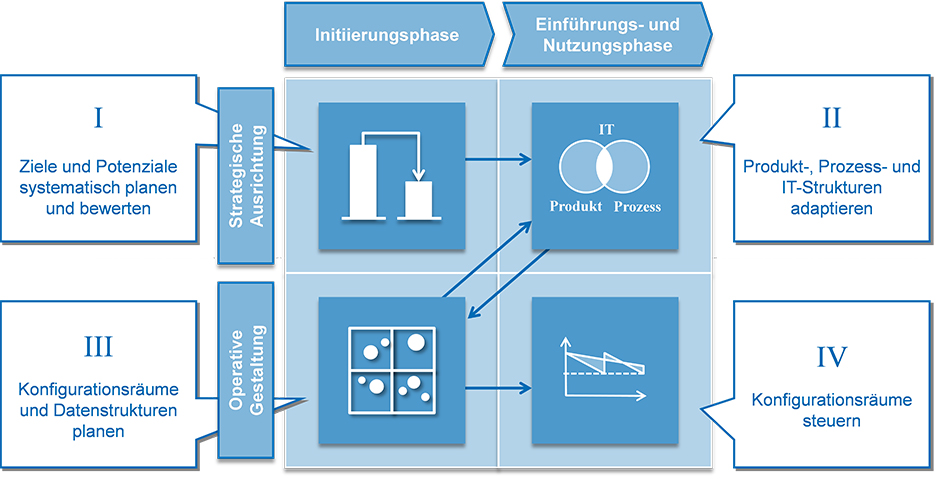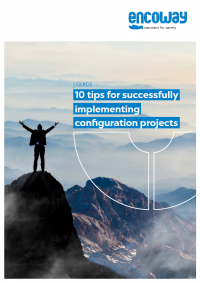In recent years, sales order processing has become increasingly complex. This is attributable to the growing variety within product ranges and their lack of controllability. Product configurators, and solution or system configurators can provide valuable help in dealing with this diversity. However, their implementation in the company often fails due to the lack of a systematic approach. Knowing why a project has failed is a valuable basis for an improved approach to new configuration projects.
Configuration projects fail due to a wide number of challenges
When implementing a configuration project, companies face all sorts of challenges. If the objectives and requirements of a product configurator have not been clearly and transparently defined or are subject to change over time, the task will be formidable right from the start. As in traditional IT projects, moving targets will greatly affect the project’s success. And the large number of stakeholders involved in a configuration project further complicates the necessary target definition.
Other challenges during a configuration project arise from the interaction with the IT systems throughout the order fulfilment process. The product configurator interacts with the PLM and ERP systems of the company and utilises the configuration knowledge stored in its databases. The more heterogeneous the IT landscape of a company is, the more complexis the implementation of a product configurator.
A configuration project does, however, involve more aspects than a traditional IT project. A configurator is not just an IT tool with which a valid product configuration can be determined using available components. Its full benefit becomes apparent throughout the entire product life cycle and in all relevant corporate functions. The product range and the organisational processes in the company will therefore present additional challenges.
From an organisational point of view, the harmonising process structures within the company form the basis for a successful configuration project. Often, however, an excessive amount of special orders are processed using the product configurator. When there is no clear differentiation between the processes for standard orders and for special orders, the potential benefits of a configurator cannot be fully utilised.

The product structure should be take the form of a configurable modular system. In this way, product variants can be generated using a flexible combination of modules. Without a configurable product structure and a clearly defined configuration space, the potential benefits cannot be fully exploited. Even after successful implementation, the configuration space should be constantly monitored and regularly adjusted.
The failure of a configuration project can be prevented
All these aspects need to be adequately addressed in the course of the configuration project. Otherwise the potential benefits of the product configurator cannot be fully and sustainably implemented. In order to avoid the risk of failure of a configuration project, the product configurator should be implemented in a systematic, structured way.
The four-step system for a successful project
A systematic approach to the implementation of a product configurator involves four steps:
- Assessment of objectives and potentials
- Adaptation of product, process and IT structures
- Planning of configuration spaces and data structures
- Continuous control of configuration space.
This approach addresses – on a strategic and operative level – not only the initiation stage of the configuration project but also the implementation and initial use of the product configurator.

Step 1: Systematic planning of objectives and potential
In the first step, the objectives of the relevant corporate functions are systematically recorded and a detailed evaluation of the benefits is carried out. Using a product configurator, the sales department, for example, is able to generate an offer that reflects the specific customer requirements. The product configurator allows the quick calculation of price and delivery times. Within the company, however, the focus is on the physical description of the product. Here, the configurator allows the automation of processes such as the creation of bills of materials and routings, and the generation of orders.
The qualitative analysis of the benefits from the viewpoint of the various business functions is complemented by a monetary valuation. Here, an assessment is provided on how a simplified generation of bills of materials and routings effects the complexity of cost and lead times. The monetary evaluation is then summarised and a consolidated comparison with the investment required for the implementation of a product configurator is provided.
Step 2: Adaptation of products, processes and IT structures
In the second step, the processes for standard and special orders are clearly differentiated from one another. Standard orders are processed using the product configurator and are part of the configuration space. Here, the production is largely forecast-based with a late customer order decoupling point. Special orders are processed independently of this on a job-specific basis. This allows the source-based allocation of costs, preventing cross-subsidisation of exotic variants.
In addition, the prerequisites for a product configurator in terms of the product have to be generated. Existing product structures must be transformed into a configurable form. An effective way of doing this is to design the product structure modularly. Finally, possibilities for combining modules with the respective dos and don’ts for combinations are defined in the product configurator.
Step 3: Planning of configuration spaces and data structures
In the third step, the description of the product range for the configurator takes place within the appropriate data structures. This is often accompanied by a reduction in product complexity. Variants with particularly high sales are included as standard in the product configurator. Other variants are either offered as special versions or are removed from the product range.
Step 4: Control of configuration space
Following the initial implementation of the product configurator, the fourth and final step involves the constant control of the configuration space. The proportion of the variants maintained by the product configurator is therefore kept at a high level. Each order is checked rigorously to determine whether it can be successfully configured. Special orders should not be configured if a low-cost integration in the product configurator is not possible.
Only with a holistic approach can configuration projects be successfully implemented. It is crucially important to take into account the views of all the stakeholders. A configuration project should therefore not be mistaken for a pure IT project. On the contrary, the implications for the company’s products and processes have to be considered. Only then can the potential of a product configurator be fully exploited, and ensured on a sustainable basis.
Special thanks to Mr Christian Mattern, researcher at the Laboratory for Machine Tools and Production Engineering (WZL) of the RWTH Aachen University for drafting this article.

Chief Engineer, WZL of RWTH Aachen
LinkedIn





